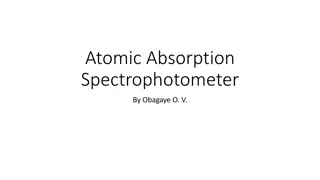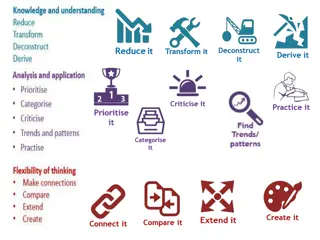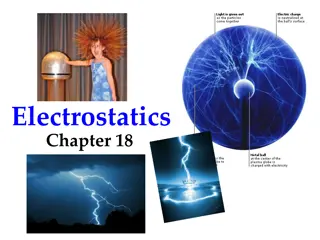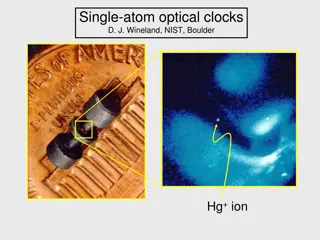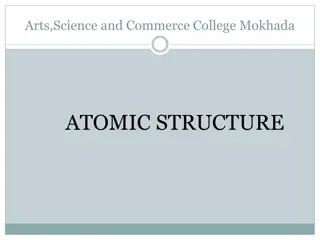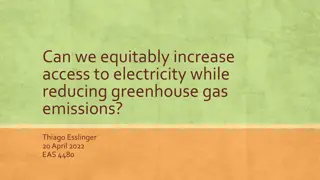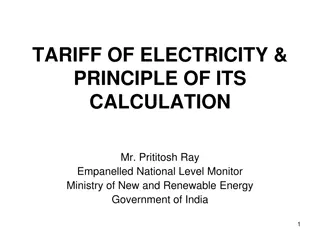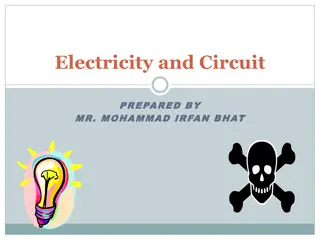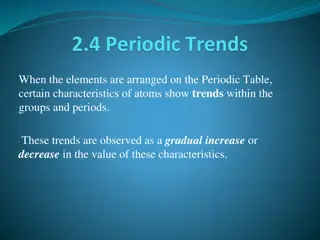Understanding Electricity at the Atomic Level
Explore the fascinating world of electricity at the atomic level, delving into concepts such as the movement of electrons, components of an atom, electron orbits, atomic numbers, and the behavior of elements like copper and sulfur. Discover how these fundamental principles shape the properties of matter and influence conductivity.
Download Presentation

Please find below an Image/Link to download the presentation.
The content on the website is provided AS IS for your information and personal use only. It may not be sold, licensed, or shared on other websites without obtaining consent from the author. Download presentation by click this link. If you encounter any issues during the download, it is possible that the publisher has removed the file from their server.
E N D
Presentation Transcript
Science of Electricity Unit 1
Electricity Movement of electrons Invisible force that provides light, heat, sound, motion . . .
Electricity at the Atomic Level Elements The simplest form of matter Atoms Smallest piece of an element containing all of the properties of that element
Electricity at the Atomic Level Components of an Atom Nucleus The center portion of an atom containing the protons and neutrons Protons Positively charged atomic particles Neutrons Uncharged atomic particles
Electricity at the Atomic Level Atomic Number The atomic number is equal to the number of protons in the nucleus of an atom. The atomic number identifies the element. How many protons are in this nucleus?
Electricity at the Atomic Level Electrons Negatively charged particles Electron Orbitals Orbits in which electrons move around the nucleus of an atom 3D 2D Valence Electrons The outermost ring of electrons in an atom
Electricity at the Atomic Level Electron Orbits Orbit Number 1 2 3 4 5 6 Valence Orbit Max # of Electrons = 2n2 n = Orbit Number Maximum Electrons 2 2 8 18 32 50 72 8 Orbits closest to the nucleus fill first
Electricity at the Atomic Level Electron Orbits Atoms like to have their valence ring either filled (8) or empty(0) of electrons. Copper How many electrons are in the valence orbit? Cu 1 29 Is copper a conductor or insulator? Conductor Why?
Electricity at the Atomic Level Electron Orbits Sulfur S 16 How many electrons are in the valence orbit? 6 Is sulfur a conductor or insulator? Insulator Why?
Electricity at the Atomic Level Electron Flow An electron from one orbit can knock out an electron from another orbit. When an atom loses an electron, it seeks another to fill the vacancy. Copper Cu 29
Electricity at the Atomic Level Electron Flow Electricity is created as electrons collide and transfer from atom to atom. Play Animation
Conductors and Insulators Conductors Insulators Electrons flow easily between atoms Electron flow is difficult between atoms 5 8 valence electrons in outer orbit 1 3 valence electrons in outer orbit Examples: Mica, Glass, Quartz Examples: Silver, Copper, Gold, Aluminum
Conductors and Insulators Identify conductors and insulators Insulators Conductors
Electrical Circuit A system of conductors and components forming a complete path for current to travel Properties of an electrical circuit include Voltage Current Resistance Volts Amps Ohms V A
Current The flow of electric charge - measured in Amperes (A) Tank (Battery) Faucet (Switch) Pipe (Wiring) When the faucet (switch) is off, is there any flow (current)? NO When the faucet (switch) is on, is there any flow (current)? YES
Current in a Circuit off off on on When the switch is off, there is no current. When the switch is on, there is current.
Current Flow Conventional current assumes that current flows out of the positive side of the battery, through the circuit, and back to the negative side of the battery. This was the convention established when electricity was first discovered, but it is incorrect! Electron flow is what actually happens. The electrons flow out of the negative side of the battery, through the circuit, and back to the positive side of the battery. Conventional Current Electron Flow
Voltage The force (pressure) that causes current to flow - measured in Volts (V) Tank (Battery) Faucet (Switch) Pipe (Wiring) When the faucet (switch) is off, is there any pressure (voltage)? YES Pressure (voltage) is pushing against the pipe, tank, and the faucet. When the faucet (switch) is on, is there any pressure (voltage)? YES Pressure (voltage) pushes flow (current) through the system.
Voltage in a Circuit off off on on The battery provides voltage that will push current through the bulb when the switch is on.
Resistance The opposition of current flow - measured in Ohms( ) Tank (Battery) Faucet (Switch) Pipe (Wiring) What happens to the flow (current) if a rock gets lodged in the pipe? Flow (current) decreases.
Resistance in a Circuit off on Resistors are components that create resistance. Reducing current causes the bulb to become more dim.
Ohms Law Current in a resistor varies in direct proportion to the voltage applied to it and is inversely proportional to the resistor s value The mathematical relationship between current, voltage, and resistance If you know two of the three quantities, you can solve for the third. Quantities Abbreviations Units Symbols Voltage V Volts V Current I Amperes A Resistance V=IR R Ohms R=V/I I=V/R
Ohms Law Chart Cover the quantity that is unknown. Solve for V V x V=IR I R
Ohms Law Chart Cover the quantity that is unknown. Solve for I V I=V/R I R
Ohms Law Chart Cover the quantity that is unknown. Solve for R V R=V/I I R
Example: Ohms Law The flashlight shown uses a 6-volt battery and has a bulb with a resistance of 150 . When the flashlight is on, how much current will be drawn from the battery? Schematic Diagram IR V + VT = VR I R - V 6 V = = 0.04 = 40 = I A mA R R 150 R
Circuit Configuration Components in a circuit can be connected in one of two ways. Parallel Circuits Both ends of the components are connected together. There are multiple paths for current to flow. Series Circuits Components are connected end-to-end. There is only a single path for current to flow. Components (i.e., resistors, batteries, capacitors, etc.)
Electrical Power Electrical power is directly related to the amount of current and voltage within a system. P = I V Power is measured in watts







